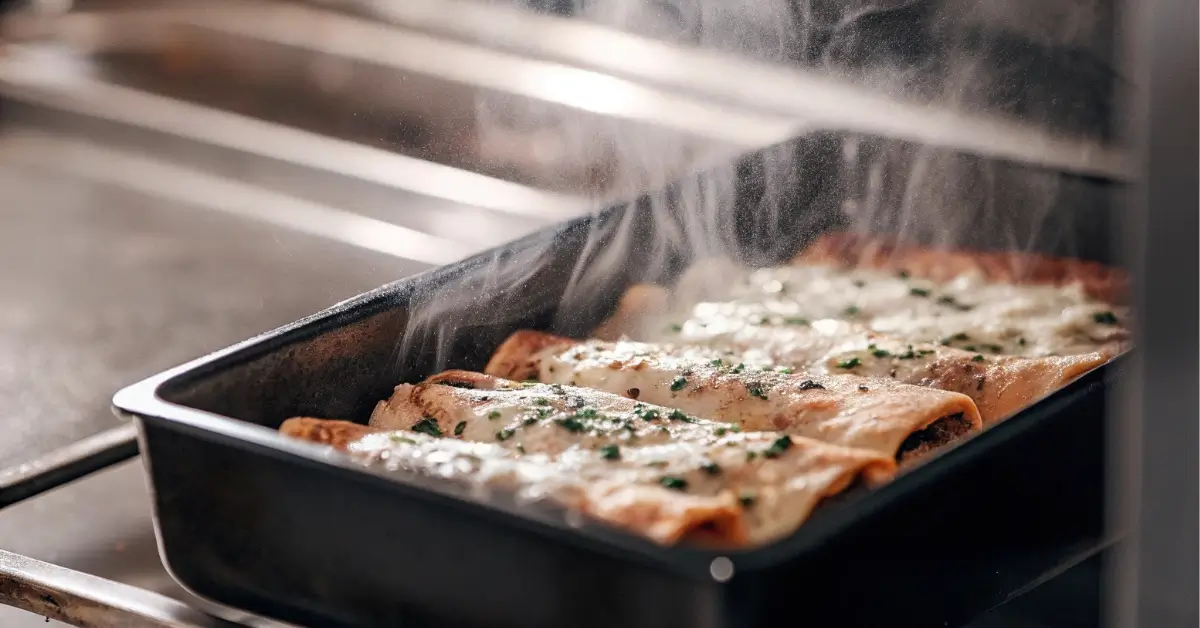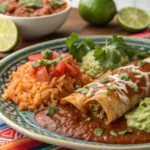Whether you’re whipping up a quick weeknight dinner or crafting a full-on Mexican feast, one big question stands between you and cheesy perfection: how long to cook enchiladas? Timing matters. Too short, and you’ve got cold centers. Too long, and everything turns dry and tough. This complete guide will walk you through every angle of enchilada baking—from temperatures and cooking times to reheating leftovers without ruining them.
We’ll break down how long enchiladas take to cook at different oven settings, how covering or not covering them changes the outcome, and what signs show they’re ready to devour. You’ll also learn the right way to reheat enchiladas, the cooking time differences between meat and cheese fillings, and common mistakes to avoid.
Looking for inspiration? Try how to make chimichangas if you’re into crispy rolled alternatives!
Let’s dive in and make sure your enchiladas come out of the oven hot, melty, and perfectly cooked.
Jump to:
Understanding the Basics of Cooking Enchiladas
What Are Enchiladas? A Quick Overview
Enchiladas are a traditional Mexican dish made by rolling tortillas around a savory filling—commonly cheese, chicken, or beef—and topping them with sauce and cheese before baking. But regardless of what’s inside, the key to a mouthwatering bite is knowing how long to cook enchiladas and at what temperature. Getting that timing right ensures the tortillas stay tender, the cheese melts just right, and the filling is hot all the way through.
You can use corn or flour tortillas, homemade or store-bought enchilada sauce, and a variety of toppings. While enchiladas seem straightforward, the bake time depends on a few variables—including oven temp, thickness, and ingredients.
Why Cooking Time Matters for Flavor and Safety
Getting the enchiladas bake time correct is about more than just flavor—it’s also a food safety issue. Chicken or ground beef enchiladas need to reach a safe internal temperature of 165°F to be fully cooked. Cheese enchiladas are more forgiving but still benefit from proper heating to melt completely and allow flavors to blend.
Cooking too long can dry out the tortillas and cause the cheese to harden instead of staying gooey. On the flip side, undercooked enchiladas may taste bland or even be unsafe to eat—especially with meat fillings.
When asking how long to cook enchiladas, remember the golden rule: it’s not just about the time on the clock, but the combination of oven temperature, filling, and layering that determines success.
How Long to Cook Enchiladas in the Oven
Standard Baking Time at 350°F, 375°F, and 400°F
Wondering how long to cook enchiladas in a conventional oven? The most common baking temperature is 350°F, which cooks enchiladas evenly and allows the flavors to develop without drying out the tortillas or overcooking the filling. At this temperature, the ideal cook time for enchiladas is between 20 and 25 minutes, especially when using pre-cooked chicken, beef, or cheese.
Here’s a quick chart for reference:
| Oven Temperature | Bake Time | Best Use Case |
|---|---|---|
| 350°F | 20–25 minutes | General use, great for all fillings |
| 375°F | 18–22 minutes | Slightly faster, more browning |
| 400°F | 15–20 minutes | Quicker cook, crispier edges |
At 375°F, you’ll cut down the baking time slightly, which is great when you’re cooking for a crowd or aiming for extra cheesy bubbles on top. At 400°F, you need to watch closely. The enchiladas bake faster, but risk drying out if left too long.
So, how long to cook enchiladas depends on your oven setting—but anywhere between 15 to 25 minutes is your sweet spot for melty, moist, and golden enchiladas.
How Long to Cook Enchiladas at 425°F and Higher Temps
If you’re cranking up the oven to 425°F, you’re going for that bold flavor and browned top. But the question remains: how long do you cook enchiladas at 425°F? The sweet spot here is 12 to 15 minutes—just enough to melt everything and crisp the tortillas.
For ultra-high temps like 450°F, bake for 10–12 minutes tops. But beware: without foil, the edges of your enchiladas could burn quickly. To avoid this, cover with foil for the first half and remove during the last few minutes.
Want to master quick-cook meals beyond enchiladas? Check out our air fryer ribs recipe—a great example of flavor meets speed.
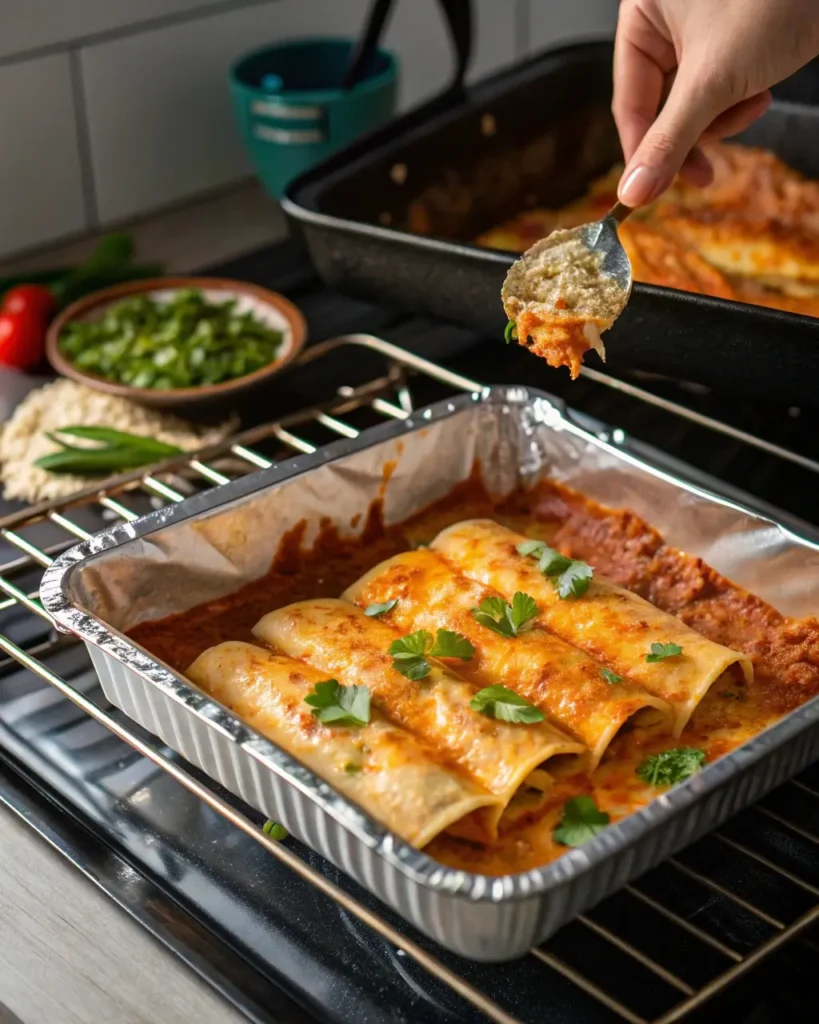
Covered vs. Uncovered: Which Method Works Best?
Should You Cover Enchiladas While Baking?
A big part of getting how long to cook enchiladas just right is knowing whether to cover or uncover them in the oven. Covering enchiladas traps steam, keeping the tortillas moist and the filling hot without drying everything out. The best method? Cover enchiladas for the first two-thirds of baking, then uncover for the final minutes.
For example, at 350°F for 25 minutes, cover with foil for 15–20 minutes, then remove foil for the last 5–10 minutes. This gives you a melty, moist inside and a golden, bubbly top.
| Baking Method | Covered Time | Final Result |
|---|---|---|
| Fully Covered | 100% | Soft, moist enchiladas |
| Partially Covered | ⅔ time | Moist with crispy topping |
| Uncovered | 0% | Risk of dryness or burning |
So yes, if you’re serious about knowing how long to cook enchiladas, don’t skip the foil.
Want another cozy dinner idea where foil makes a big difference? Try our easy Salisbury steak recipe.
How Covering Impacts Texture and Moisture
Covering your enchiladas while baking locks in steam and sauce, which keeps the tortillas soft and the cheese extra melty. If you skip the foil, your enchiladas may crisp too soon—leaving the inside undercooked.
Also, foil helps maintain even heat, especially when you’re baking at 375°F or 400°F. Using foil is a secret weapon in mastering how long to cook enchiladas the right way.
How to Know When Enchiladas Are Fully Cooked
Signs Your Enchiladas Are Done (Visual & Temperature)
Even when you follow instructions on how long to cook enchiladas, knowing when they’re truly ready makes all the difference. Visual cues and temperature checks help you avoid soggy centers or burnt tops.
Key signs your enchiladas are cooked:
- Cheese is bubbling and fully melted
- Tortillas are slightly golden and crispy on the edges
- Sauce is hot and sizzling
- Internal temperature reaches 165°F for meat fillings
Using a thermometer helps confirm whether your enchiladas are ready, especially when using raw or pre-cooked meats.
Need help with temp checking? Our smoked salmon temperature guide offers similar insight for other proteins.
Tips to Prevent Overcooking or Burning
Overcooked enchiladas have hard tortillas and rubbery cheese—a far cry from the gooey perfection we want. Undercooked ones stay cold inside and often look dull and unappetizing.
Avoid these mistakes by:
- Using a kitchen timer
- Preheating your oven properly
- Baking on the center rack
- Covering with foil early and uncovering late
All these tips revolve around perfecting how long to cook enchiladas without overbaking or undercooking.
How Long to Reheat Enchiladas Properly
Reheating at 350°F: What to Expect
If you’re asking how long to cook enchiladas again when reheating, don’t worry—you’ve got options. Reheating enchiladas in the oven at 350°F is the gold standard.
Steps to reheat:
- Preheat oven to 350°F
- Cover enchiladas with foil
- Bake for 20 to 25 minutes
- Check internal temp to hit 165°F
| Method | Temp | Time | Texture |
|---|---|---|---|
| Oven | 350°F | 20–25 mins | Crispy & moist |
| Microwave | Medium | 2–3 mins | Soft, fast heat |
| Air fryer | 360°F | 8–10 mins | Crunchy top |
Add extra sauce or broth if needed to prevent drying out during reheating. If you’re working with frozen enchiladas, see Part 6.
Want another sweet dish that reheats well? Don’t miss our banana pudding with Chessman cookies.
Microwave vs Oven: Best Practices for Warming Up
In a hurry? The microwave works—but isn’t ideal. Enchiladas can get rubbery, especially the tortillas. Always cover with a damp paper towel and heat in short intervals.
If you want restaurant-quality reheated enchiladas, stick with the oven and remember: how long to cook enchiladas again depends on portion size and starting temp.
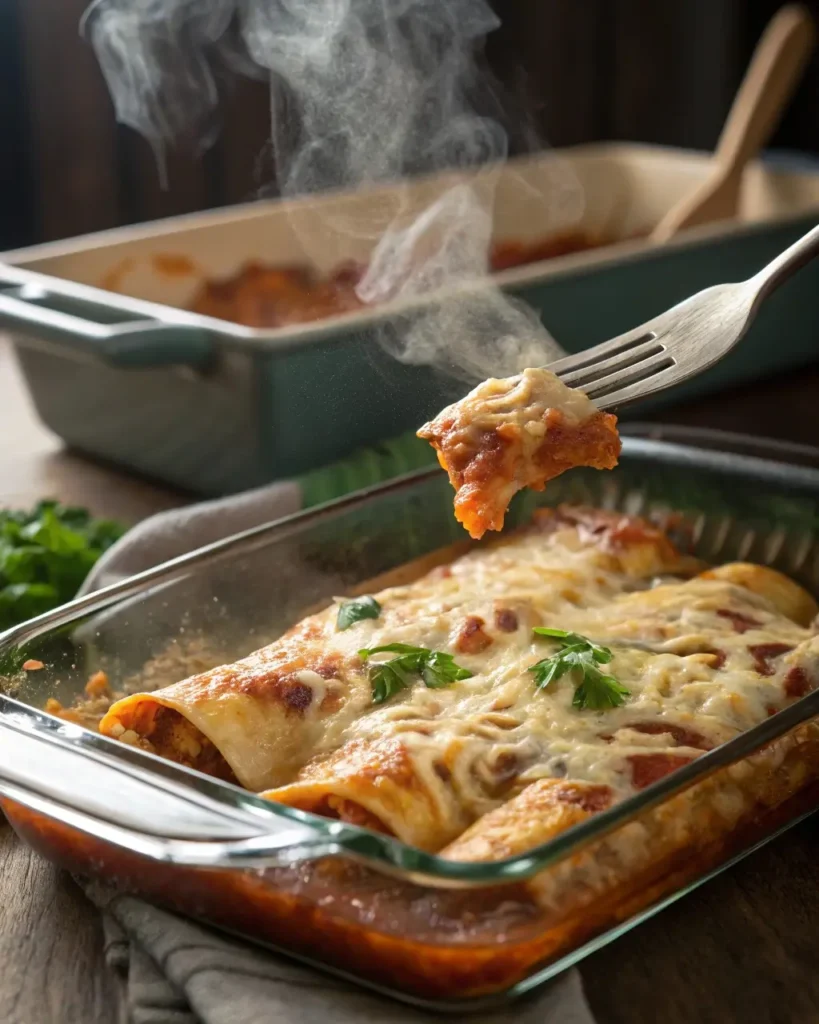
Cooking Different Types of Enchiladas
Meat vs Cheese Enchiladas: Do Times Vary?
Yes—how long to cook enchiladas depends heavily on the filling. Cheese-only enchiladas heat through faster, while meat-filled ones—especially with raw meat—take longer.
| Filling Type | Oven Temp | Cooking Time | Key Tip |
|---|---|---|---|
| Cheese | 350°F | 20–25 minutes | Watch for bubbling cheese |
| Pre-cooked meat | 350°F | 25–30 minutes | Ensure heated center |
| Raw meat | 350°F | 35–40 minutes | Always check internal temp |
| Veggies | 350°F | 20–25 minutes | Use foil to prevent drying |
Cold fillings straight from the fridge delay cooking time and can leave you wondering why your enchiladas aren’t hot inside. Let ingredients sit at room temp for 15–20 minutes before baking.
For more colorful Mexican ideas, check out our Mediterranean salmon—a light, vibrant pairing with enchiladas.
Frozen Enchiladas: How Long to Bake From Frozen
Wondering how long to cook frozen enchiladas? Here’s your go-to plan:
- Preheat oven to 375°F
- Cover with foil
- Bake for 45 to 50 minutes
- Remove foil and bake another 10 minutes to crisp
| State | Temp | Time | Notes |
|---|---|---|---|
| Frozen | 375°F | 45–50 mins | Longer time, always foil |
| Thawed | 350°F | 25–30 mins | Same as fresh enchiladas |
Want more freezer-friendly ideas? Try our Mexican food chimichanga—great from frozen or fresh!
Top Mistakes That Ruin Enchiladas
Overcooking, Undercooking, and Uneven Heating
A perfect enchilada should be melty, moist, and just the right amount of crispy on top. But one misstep in timing or prep, and your dish can fall flat. Let’s break down the biggest issues that ruin enchiladas—starting with the most obvious: overcooking or undercooking.
Overcooked enchiladas often have:
- Dry, brittle tortillas
- Rubber-like cheese
- Burnt sauce edges
Undercooked enchiladas, on the other hand, may:
- Have cold or lukewarm fillings
- Contain unmelted cheese
- Taste flat or doughy in texture
If you’re unsure how long to cook enchiladas, it’s better to err on the side of undercooking and check mid-way with a thermometer. For meat-based versions, the center should reach 165°F. Cheese-only enchiladas are done when the top is bubbly and the edges begin to brown.
Another culprit? Uneven heating. If your enchiladas are cooked on one side and raw on the other, it could be due to:
- Not preheating your oven
- Using a pan that’s too big or too deep
- Placing the dish too high or too low in the oven
Use the middle rack for even air circulation and a glass or ceramic baking dish for stable heating.
If you’ve ever had a meal go from delicious to disaster, check out our recovery tips like these banana cake mix tricks—a good example of how small changes affect big results.
Using Cold Fillings: Why It Delays Cooking Time
This mistake is sneaky—but serious. If you pull your filling straight from the fridge and roll it into your tortillas, you’re almost guaranteed to end up with undercooked enchiladas or longer-than-expected baking times.
Here’s why that matters:
- Cold fillings lower the overall pan temperature, making your oven work harder and longer
- You risk the outer edges overcooking before the middle is fully heated
- The top may brown too fast while the cheese inside stays firm
Solution? Let your filling sit at room temp for 15–20 minutes before assembly. That way, you’re not starting from cold, and you can bake your enchiladas evenly at the standard 350°F to 375°F range.
| Mistake | Result | Fix |
|---|---|---|
| Overcooking | Dry tortillas, burnt cheese | Stick to proper bake times |
| Cold filling | Center stays cold, uneven cook | Let filling warm slightly |
| No foil at start | Over-browned top, dried sauce | Use foil for first ⅔ of baking |
| Pan too deep | Longer cook time, soggy bottom | Use shallow baking dishes |
Want more “before and after” advice on recipe timing? Don’t miss our how to smoke salmon in a smoker article—it covers temperature control like a pro.
Expert Tips for Perfectly Baked Enchiladas Every Time
Temperature Control and Rack Positioning
One of the most overlooked factors in cooking enchiladas just right? Oven rack positioning. Where you place your dish can seriously impact how long to cook enchiladas and how evenly they bake.
- Middle rack = ideal for even heat distribution
- Lower rack = more bottom crisping, useful for soggy tortillas
- Top rack = more direct heat, good for browning the top in final minutes
Set your oven to 350°F to 375°F for the most reliable results and always preheat before baking. Skipping preheating can lead to overbaked exteriors and undercooked centers—especially if you’re baking with cheese or meat fillings.
Make sure the enchiladas are arranged in a single, even layer in the pan, and leave some space between rolls for heat to circulate. You’ll get a better melt, a more consistent texture, and you won’t have to guess how long to cook enchiladas each time.
Looking for similar heat-control hacks? Discover our air fryer salmon bites for another example of how precise cooking makes a major difference.
Preheating, Resting Time, and Garnishing Hacks
Here’s a pro sequence that takes enchiladas to the next level:
- Preheat your oven fully (no shortcuts!)
- Bake covered, then uncover at the end to finish crisping
- Let enchiladas rest 5–10 minutes before serving
- Garnish smartly with fresh toppings like:
- Chopped cilantro
- Sliced jalapeños
- Sour cream or crema
- Crumbled queso fresco
- Diced avocado or guacamole
Resting is critical. Not only does it prevent burning your mouth, but it also allows the sauce to thicken, cheese to settle, and tortillas to firm up for easier serving.
If your enchiladas are saucy, placing a layer of foil or parchment under the dish while baking can help with cleanup, especially if the pan bubbles over. It won’t affect how long to cook enchiladas, but it’ll save you some elbow grease.
Want to impress dinner guests with presentation? Learn how to serve show-stopping mains with tips from our crepe cake article—perfect when paired with Mexican favorites.
Pairing Ideas and Serving Suggestions
Best Sides to Serve With Enchiladas
A plate of enchiladas is satisfying on its own, but the right side dish can turn a simple meal into a memorable feast. When planning your meal, consider textures, colors, and complementary flavors to round things out.
Here are some classic and creative pairings:
| Side Dish | Why It Works |
|---|---|
| Mexican rice | Absorbs sauce, adds bulk to the meal |
| Refried or black beans | Earthy and rich, a classic pairing |
| Elote (Mexican street corn) | Sweet, smoky, and creamy contrast |
| Guacamole + tortilla chips | Crunch and coolness balance warm enchiladas |
| Cilantro lime coleslaw | Fresh, acidic crunch cuts the richness |
| Pickled red onions | Adds zing and color contrast |
Looking for inspiration? Try our Spanish rice recipe—it’s a perfect base for soaking up enchilada sauce and keeping every bite juicy and flavorful.
For a lighter option, consider a cucumber and tomato salad with lime vinaigrette to cleanse the palate between bites.
How Serving Style Affects Taste and Presentation
The way you plate enchiladas can have a major impact on both texture and flavor. Serving straight from the baking dish keeps everything hot, but individual plating gives you room for creative garnishes and smart portioning.
Tips for next-level serving:
- Plate on warmed dishes to maintain temperature
- Add sour cream or crema in a swirl, not a blob
- Stack enchiladas slightly overlapping to hold heat
- Garnish with fresh herbs or sliced chilies for brightness
- Sprinkle cotija or queso fresco for extra texture
You can also go fusion! Pair enchiladas with unconventional sides like sweet plantains, grilled pineapple, or even a spicy mango salsa.
For a full Mexican-themed dinner, don’t miss our guide to quesillo—the silky smooth dessert. It’s the ultimate way to wrap up a rich, savory enchilada meal.
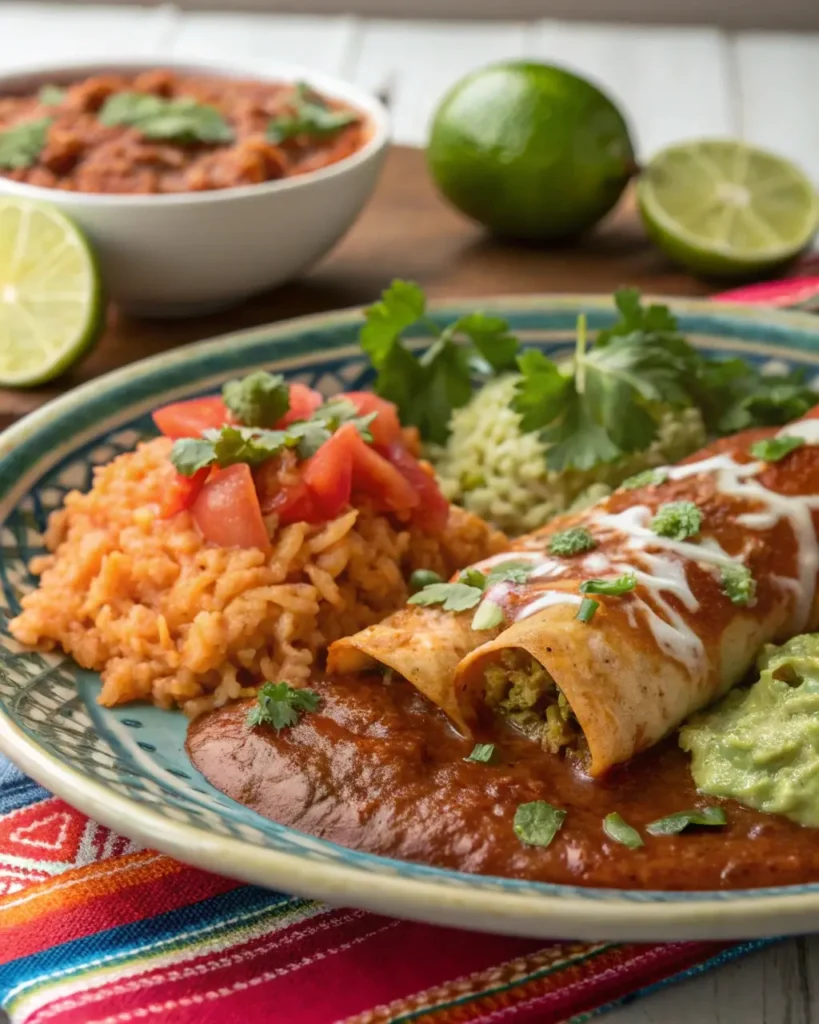
FAQ: How Long to Cook Enchiladas – Common Questions Answered
How long do you leave enchiladas in the oven?
For most recipes, you should bake enchiladas at 350°F for 20 to 25 minutes if your filling is already cooked. For raw meat fillings, extend that time to around 35–40 minutes. Covering the dish with foil helps retain moisture and ensures even heating. For extra browning, remove the foil for the last 5 minutes of baking.
How long to heat up enchiladas at 350 degrees?
When reheating enchiladas at 350°F, bake them for 20 to 25 minutes if coming from the fridge. Cover the dish with foil to prevent drying out. If reheating from frozen, increase the time to 45–50 minutes, and always ensure the internal temperature reaches 165°F.
How long to cook an enchilada?
The answer depends on the oven temperature and filling type. Typically, enchiladas cook at:
350°F for 20–30 minutes
375°F for 18–25 minutes
425°F for 12–15 minutes
Always check that the cheese is bubbling and the center is fully heated.
Should I cover enchiladas when baking?
Yes, especially for the first two-thirds of the cooking time. Covering enchiladas with foil helps trap heat and steam, preventing the tortillas from drying out. Remove the foil during the last few minutes to crisp up the top and get that golden, cheesy finish.
How long to cook enchiladas at 425 degrees?
If you’re baking at 425°F, enchiladas typically take 12 to 15 minutes. This higher temp is ideal for getting a bubbly top and crispy edges quickly. However, use foil if your enchiladas are thick or filled with meat to avoid burning the outer layers before the center is fully heated.
How do you know when enchiladas are done?
Your enchiladas are ready when:
The cheese is fully melted and bubbling
The edges of the tortillas are slightly golden
The internal temperature is at least 165°F, especially for meat
The sauce is hot and sizzling around the edges
Letting the dish rest for 5–10 minutes after baking helps everything settle and improves the flavor.
Conclusion: Mastering the Art of Enchilada Cooking
Getting enchiladas just right doesn’t have to be a guessing game. Whether you’re baking from scratch, reheating leftovers, or cooking a frozen batch, the real key is understanding how long to cook enchiladas based on oven temp, fillings, and pan setup. Stick to 350°F–375°F for most dishes, cover during the early stages, and always check for bubbling cheese and that golden edge.
Now that you know the ideal timing and technique, you’re ready to serve up hot, melty, restaurant-quality enchiladas from your own kitchen. Don’t forget to pair with the perfect side dish and garnish like a pro.
Looking for more delicious Mexican inspiration? Don’t miss our churu chicken amarillo recipe—another zesty favorite that bakes up beautifully!
PrintHow Long to Cook Enchiladas: Perfect Oven-Baked Enchiladas Every Time
Master the art of enchiladas with this foolproof method. Learn exactly how long to cook enchiladas at different temperatures, what fillings change cook time, and tips for cheesy, golden perfection.
- Prep Time: 15 minutes
- Cook Time: 25 minutes
- Total Time: 40 minutes
- Yield: 4 servings
- Category: Dinner, Main Course
- Method: Baked
- Cuisine: Mexican
- Diet: Gluten Free
Ingredients
- 8 corn or flour tortillas
- 2 cups cooked shredded chicken, beef, or cheese (your choice)
- 1 ½ cups red enchilada sauce
- 1 ½ cups shredded cheese (cheddar or Mexican blend)
- 1 tablespoon olive oil (optional, for greasing dish)
- Optional toppings: sour cream, cilantro, diced onions, jalapeños
Instructions
- Preheat oven to 350°F (or 375°F for faster baking).
- Lightly grease a 9×13-inch baking dish with olive oil.
- Warm tortillas slightly to make rolling easier.
- Spoon filling into each tortilla, roll tightly, and place seam-side down in the dish.
- Pour enchilada sauce evenly over the top.
- Sprinkle with shredded cheese.
- Cover the dish with foil.
- Bake covered for 20–25 minutes (350°F) or 18–22 minutes (375°F).
- Remove foil for the last 5 minutes to brown the cheese.
- Let rest for 5–10 minutes before serving with toppings.
Notes
- For frozen enchiladas: Bake at 375°F for 45–50 minutes covered, then uncover for 10 minutes.
- Always ensure meat-based fillings reach 165°F internal temperature.
- Customize with black beans, corn, or sautéed veggies.
- Use foil for moist enchiladas, skip foil for a crispy top layer.

